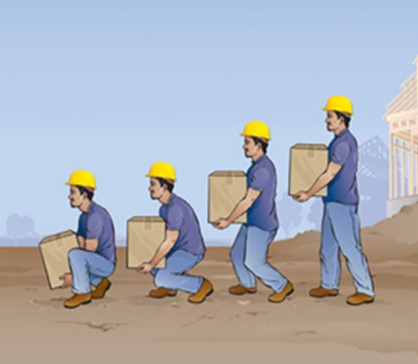The task of lifting heavy loads is a common occurrence. Whether it’s moving construction materials, tools, or equipment, mastering safe lifting techniques is paramount to preventing injuries and promoting a culture of workplace safety. Back injuries are one of the main causes of disability, and affect approximately 1 million people each year, many of them due to improperly lifting objects.
Understanding the Risks:
- Musculoskeletal Strain: Lifting heavy objects without proper technique can lead to musculoskeletal strain, affecting the back, shoulders, and other muscle groups.
- Injuries and Accidents: Improper lifting techniques contribute to a higher risk of accidents and injuries, including strains, sprains, and even more severe conditions.
Safe Lifting Basics:
- Stretching: One of the techniques for lifting heavy objects safely is to stretch before starting a long day of work.
- Assess the Load: Before lifting, assess the weight and size of the load. If it’s too heavy or awkward, seek assistance or use mechanical aids.
- Maintain a Stable Base: Stand with your feet shoulder-width apart to provide a stable base. This enhances balance and reduces the risk of slipping or stumbling.
- Bend at the Knees: When bending down to lift, bend at the knees and keep the back straight. Avoid bending at the waist, as this can strain the lower back.
- Grip and Hold: Use a firm grip on the object, with both hands if possible. Avoid pinching the load between your fingers, as this can lead to hand injuries.
- Lift with Your Legs: Engage your leg muscles to lift the load, not your back. Push up with your legs while keeping the load close to your body.
- Avoid Twisting: When carrying a load, avoid twisting your body. Instead, pivot your feet to change direction, maintaining the load close to your body.
- Team Lifting: For heavier or awkward loads, seek assistance. Team lifting not only distributes the weight but also ensures better control and reduces the risk of injury.
Utilizing Mechanical Aids:
- Hand Trucks and Dollies:
- Whenever possible, use hand trucks or dollies to transport heavy loads. These tools reduce the physical strain on the body and enhance efficiency.
- Cranes and Hoists:
- For extremely heavy loads, rely on cranes, hoists, or other mechanical lifting devices. Proper training and adherence to safety protocols are essential when operating such equipment.
By incorporating these safe lifting basics into our daily routines, we contribute to a culture of workplace safety where everyone can thrive and perform at their best.
If you, or anyone you know needs training, please refer to our training page at phoenixoshatraining.com/services/ .
Published by OSHA Phoenix on January 29, 2024


